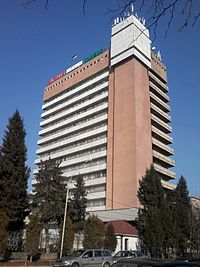
The Tajikistan health system is influenced by the former Soviet legacy. It is ranked as the poorest country within the WHO European region, including the lowest total health expenditure per capita.[1] Tajikistan is ranked 129th as Human Development Index of 188 countries, with an Index of 0.627 in 2016.[2] In 2016, the SDG Index value was 56.[3] In Tajikistan health indicators such as infant and maternal mortality rates are among the highest of the former Soviet republics. In the post-Soviet era, life expectancy has decreased because of poor nutrition, polluted water supplies, and increased incidence of cholera, malaria, tuberculosis, and typhoid. Because the health care system has deteriorated badly and receives insufficient funding and because sanitation and water supply systems are in declining condition, Tajikistan has a high risk of epidemic disease.[4]
The Human Rights Measurement Initiative[5] finds that Tajikistan is fulfilling 78.1% of what it should be fulfilling for the right to health based on its level of income.[6] When looking at the right to health with respect to children, Tajikistan achieves 96.2% of what is expected based on its current income.[6] In regards to the right to health amongst the adult population, the country achieves 97.5% of what is expected based on the nation's level of income.[6] Tajikistan falls into the "very bad" category when evaluating the right to reproductive health because the nation is fulfilling only 40.8% of what the nation is expected to achieve based on the resources (income) it has available.[6]
- ^ "Tajikistan HiT (2016)". Euro.who.int. 22 February 2019. Retrieved 22 February 2019.[permanent dead link]
- ^ "| Human Development Reports". Archived from the original on 2015-12-22. Retrieved 2018-09-09.
- ^ "Health-related SDGs - IHME Viz Hub". Vizhub.healthdata.org. Retrieved 22 February 2019.
- ^ Cite error: The named reference
cpwas invoked but never defined (see the help page). - ^ "Human Rights Measurement Initiative – The first global initiative to track the human rights performance of countries". humanrightsmeasurement.org. Archived from the original on 2022-03-08. Retrieved 2022-03-28.
- ^ a b c d "Tajikistan - HRMI Rights Tracker". rightstracker.org. Archived from the original on 2022-03-24. Retrieved 2022-03-28.